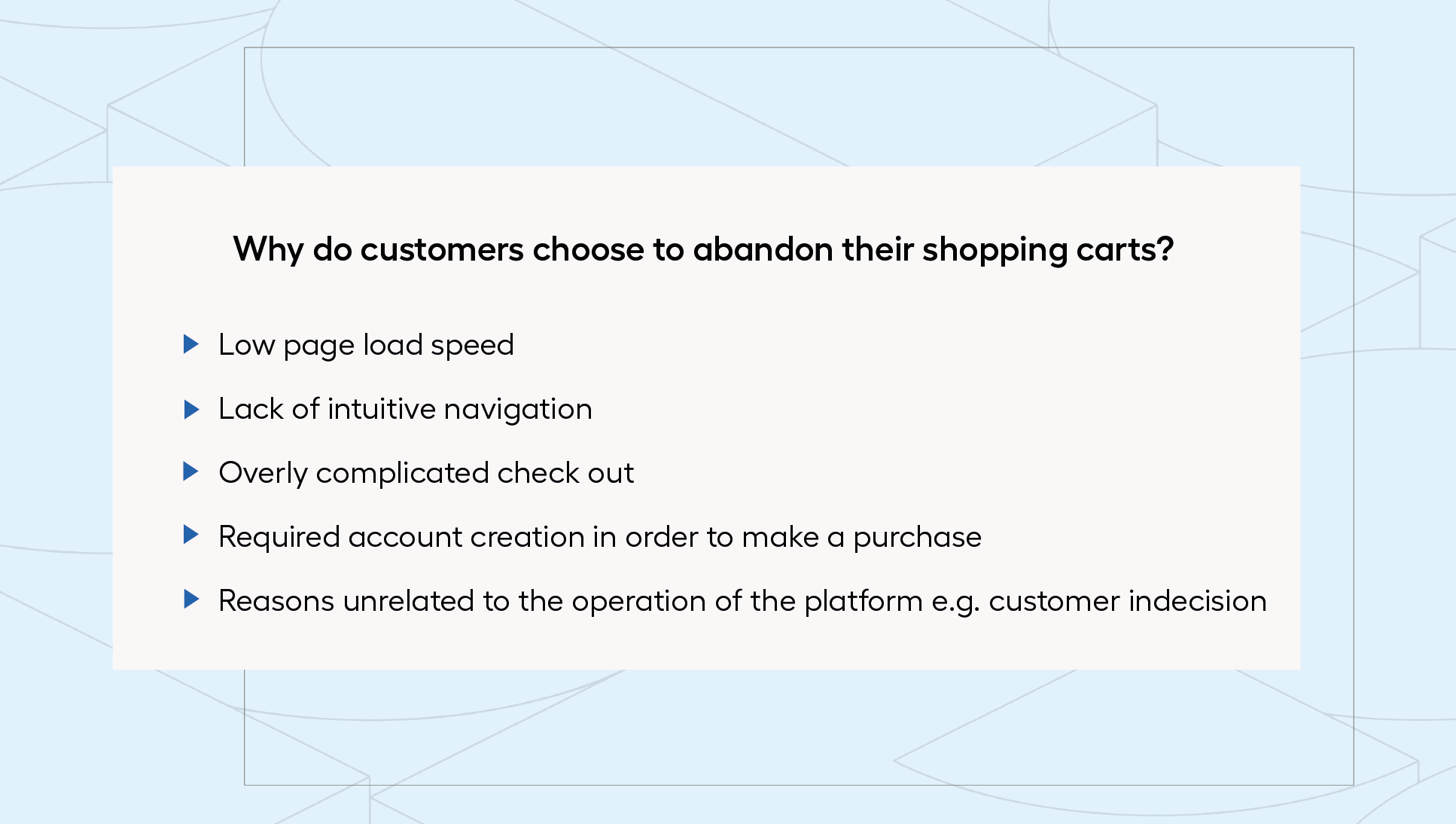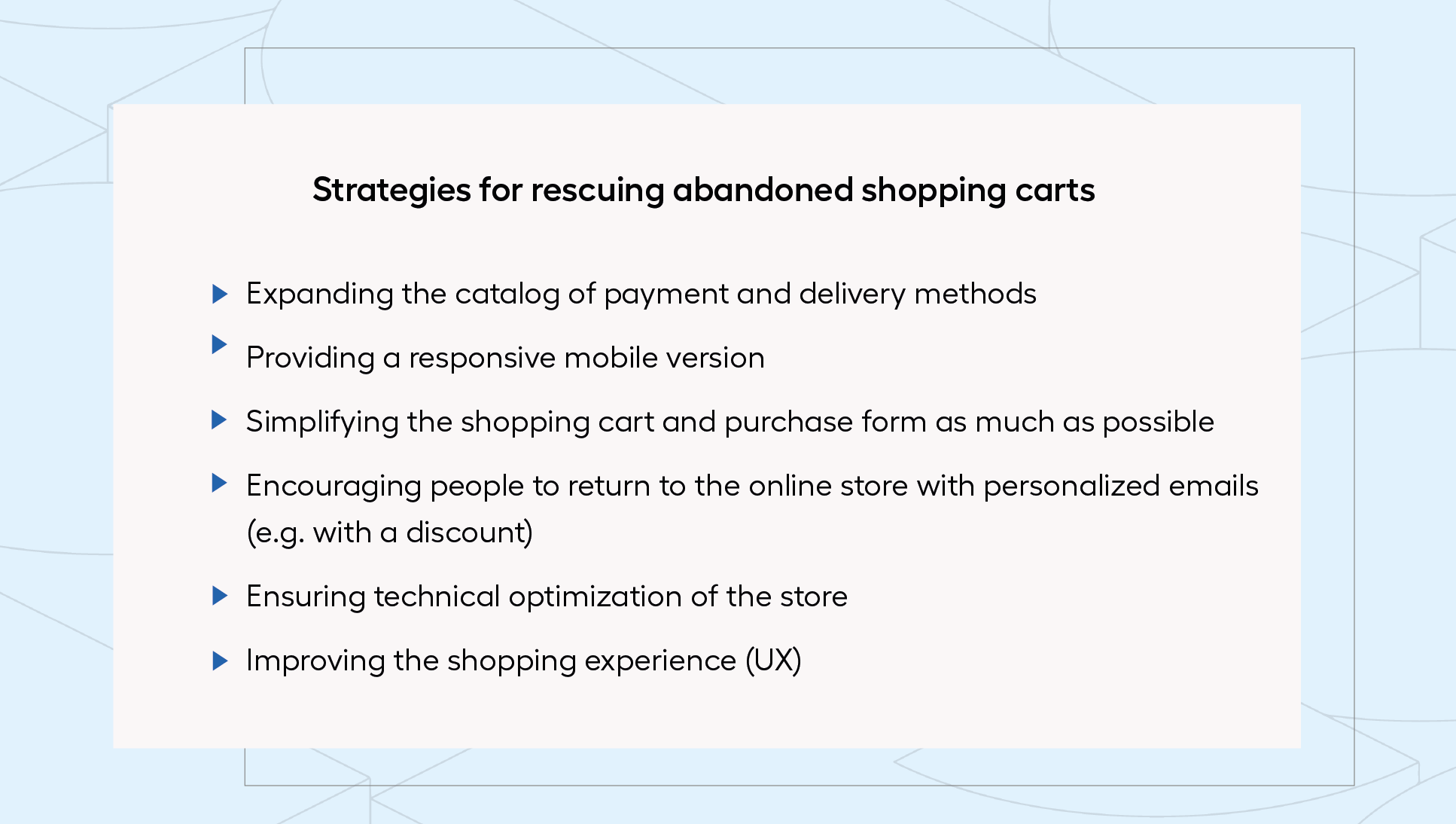Abandoned shopping carts in eCommerce - what's behind them and how to deal with them?
A potential customer spent 30 minutes in your online store, selected a few products, proceeded to the summary and began the purchase process - then in the middle, for a reason unknown to you, abandoned the offer. Such a situation is described as an abandoned shopping cart, undoubtedly one of the biggest issues for online stores worldwide, significantly reducing the possible conversion at the last stage of the shopping process. Precisely because of the lost sales opportunities, eCommerce managers are looking for ways to minimize the number of abandoned shopping carts - a few of which we list below. Feel free to read on and implement our tips in your online store!
Abandoned shopping cart = shopping opportunity?
Every online store strives to keep the number of abandoned shopping carts as low as possible. After all, the customer has already been to the site, looked at the offer, selected whatever products the shopper would like to buy - from that point it should be very close to finalizing the order, right? In reality, for a variety of reasons (both related to the online store and the consumer's attitude itself), the situation is different - but abandoning the shopping cart provides more action than leaving the site immediately after browsing the offer for a few minutes. This is because the lack of finalization gives hope that the customer will come back and make a purchase, and all that needs to be done is to discover what exactly is behind the abandonment. The stairs begin at this point - and this is why abandoned shopping carts are the ultimate bane of online stores.
Why did the customer abandon the shopping cart?
According to data published by the Chamber of Digital Economy in its report "Porzucony e-koszyk", as many as 7 out of 10 transactions in online stores fail - and the catalog of reasons why a purchase was not made can be truly endless.
At the very beginning, it's enough to mention technical errors (e.g., slow page loading speed - research shows that as many as 91% of users leave a site when it loads too slowly) or UX issues (e.g., lack of intuitive navigation, which increases the effort to find the products needed, an overly complicated shopping cart page or the need to create an account to make a purchase). It may also turn out that the customer was primarily focused on comparing different offers, and found the products selected on our website at a lower price in another store or shopping platform, which encouraged him to abandon the purchase. Such behavior is undoubtedly becoming particularly popular in times of the growing trend of smart shopping (considerate and thoughtful shopping) and the search for savings by customers due to the current economic situation.
Above, however, we have listed only a few basic reasons for abandoning a purchase related to the sales platform or offer itself. However, the reasons for shopping cart abandonment may also be rooted in the customer's indecision to make a purchase or in an order value that is too high and a rational decision not to spend money. The psychological aspects that drive the actions of eCommerce customers should also be taken into account and not just focus on looking for underdeveloped elements of online stores (although no doubt an element for improvement will always be found).

Rescuing abandoned shopping carts - how?
Rescuing abandoned shopping carts requires a strategic approach. It is worth starting by analyzing the situation in the online store, looking for behavioral patterns among customers who do not complete their transactions (with the help of, for example, Google Analytics, Hotjar or Clarity), so that only in the next step we can implement appropriate corrective actions and patiently wait for results. The changes we make should concern both the situation before the customer's visit to the site - that is, the optimization of the online store (technical,
UX and shopping form) - and the communication with the customer after the shopping cart is abandoned. To best carry out this process, it's a good idea to review the results of various studies on the factors that discourage consumers from completing a purchase.
Below we list 3 areas that you especially need to take care of if you are concerned about minimizing the number of unfinished transactions.
1. Provide a wide catalog of payment and delivery methods
No option for parcel machine delivery or payment via BLIK or deferred payments? For a certain group of consumers, the unavailability of a favorite form of delivery or payment is a reason to abandon the shopping cart at the last stage of order processing - because rarely does anyone check beforehand (before check-out) what forms in these areas are offered by a given online store. If a customer is able to find the most convenient form of delivery or payment from a competitor offering a very similar or even exactly the same product, he or she will certainly decide to switch to an online store.
How to determine which payment and delivery methods should be implemented in an online store? In this regard, it is worthwhile, first of all, to regularly check emerging reports, especially the Gemius report released every year (created in cooperation with IAB Poland and Polskie Badania Internetu organization), and analyze the changes occurring from year to year. The latest one - E-commerce in Poland 2022 - showed that 77% of Poles buy online, a:
- 70% of consumers pay for their order by quick transfer, but the popularity of BLIK payments (58% in 2022 versus 48% in 2021) and deferred payments (12% in 2022 versus 9% in 2021) is growing,
- 81% of consumers prefer parcel machine delivery.
Although InPost parcel machines definitely reign supreme when it comes to deliveries (which is also confirmed by the erection of parcel machines by other companies like Orlen, AliExpress and Allegro), trends in mobile payments are definitely worth keeping an eye on, as we can expect changes in this area in the next year.
Deciding to provide a wide catalog of payment and delivery methods (combined with tracking changes in consumer behavior) is therefore a fundamental way to minimize the number of abandoned shopping carts and ensure the highest possible sales. In this area, it's also worth thinking about consumers abandoning a purchase due to delivery costs - we are used to looking for free shipping options. So it's worth implementing, for example, a notification about the missing amount for free delivery, which encourages people to spend more on products to get free shipping.
2. Remember to keep an eye on the mCommerce trend
In the latest edition of the Gemius report, for the first time ever, the smartphone won out over the laptop as the most used device for online shopping - as many as 75% of consumers said they buy using their phone. For this reason, you should ask yourself three questions:
- whether my customers are more likely to visit the store on their phone or on a laptop (which Google Analytics will show you),
- whether the mobile version of my online store provides a positive shopping experience,
- whether customers are more likely to abandon a purchase from their phone or desktop.
After all, it is very often the case that online stores are polished in every way, but only in the desktop version, while the smaller screen of a smartphone requires the implementation of numerous improvements (e.g. to improve product browsing and ensure excellent visibility of the shopping cart or check-out). In times of rapid mCommerce development, you can't ignore the growing number of purchases made via phone and ensure responsiveness or implementation of a separate mobile version (e.g., using PWA technology).
3. Use the power of marketing automation for remarketing
A customer has abandoned a shopping cart, and you think there's nothing you can do about it anymore? This is a complete misconception, because in a customer already interested in an offer you can reignite the desire to purchase - for this purpose you can send the customer (a few hours after leaving the site) a personalized email, SMS message or notification in the mobile app with an appropriate incentive to purchase (such as a discount, a code for free delivery, an additional gift or an option to complete the order in a shorter time).
After all, it may turn out that the customer didn't make the purchase because he had to leave home urgently, for example, or he started to hesitate whether he really needed the selected products. A personalized email encouraging them to return to your store (especially if they receive additional benefits from you) can make it easier for them to make a decision raising your conversion rate. Of course, in this regard, you should remember that this type of communication should not be too frequent and pushy, as it will cause the opposite of the expected effect.
In conducting effective remarketing activities, you will be helped by the implementation of tailored marketing automation software, within which you will develop appropriate scenarios and prepare the content of messages that will go automatically to the customer when a cart abandonment situation is detected.

Abandoned shopping carts - you can deal with them
Dealing with abandoned shopping carts is undoubtedly quite a challenge for any eCommerce store, but it is strategically important. Not only does it allow you to increase conversions by encouraging an undecided customer to buy, but it's also important in terms of Google's eCommerce search positioning (a high rejection rate lowers the value of a page in the eyes of Google's robots), so this number should definitely not be ignored.
To improve your situation, therefore, decide to take 2 steps. As part of the first, using available analytical tools, try to find some rules of consumer behavior in your online store to discover the pain points that may "encourage" abandonment. Then ensure personalized communication with the customer to awaken their desire to make a purchase. The combination of these measures should reduce the number of unfinished transactions in your online store over the long term.



